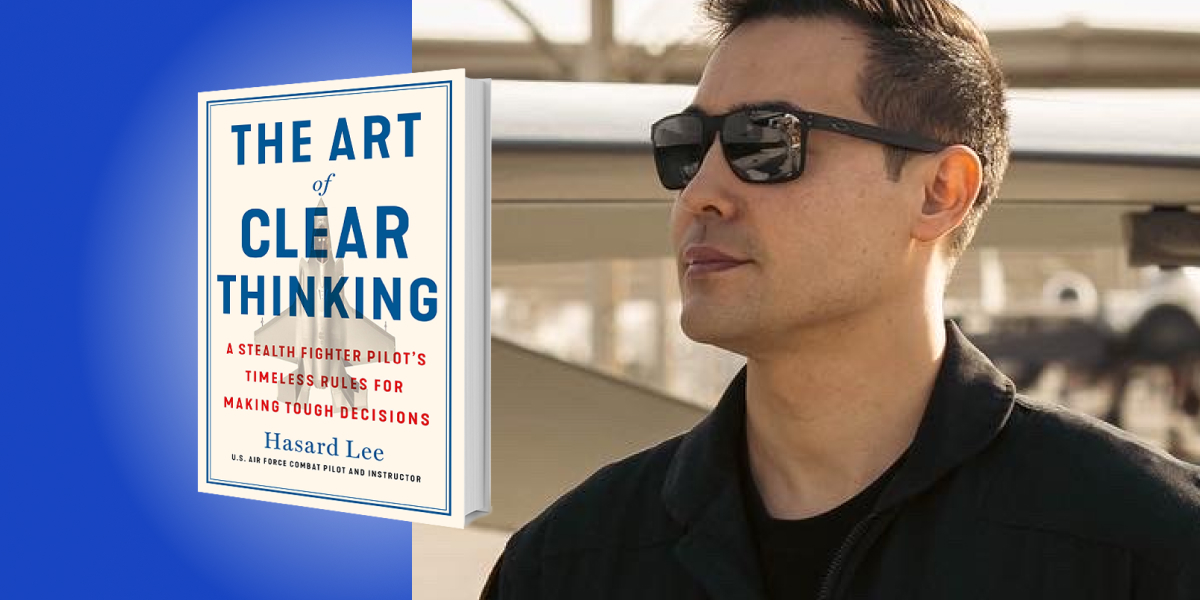Hasard Lee is a U.S. Air Force fighter pilot who began his career flying the F-16 Viper. As a flight commander, he led his pilots into combat during one of the most intense periods during the War in Afghanistan. There he flew over 80 combat missions and became the only fighter pilot to ever fly two different types of jets into combat on the same day while supporting troops under fire. Hasard was selected as the Top Instructor Pilot of the Year for the largest F-16 base in the world.
Below, Hasard shares five key insights from his new book, The Art of Clear Thinking: A Stealth Fighter Pilot’s Timeless Rules for Making Tough Decisions. Listen to the audio version—read by Hasard himself—in the Next Big Idea App.

1. Good decision-making is more important than ever.
Technology has now automated many of our lower-level tasks. This has added leverage to each decision we make. The phone you have in your pocket, by itself, can perform the job that might have required dozens of people a few decades ago. A car can travel over ten times faster than a person can run, a modern combine harvester can harvest crops hundreds of times faster than by hand, and the jet I fly allows me to be thousands of times more capable than I could be on my own.
One way to illustrate this leverage is through the energy we use. The average person, despite physically generating only one hundred watts of electricity—about what a light bulb uses—now consumes over 12,000 watts of energy. That energy powers the technology that amplifies our decisions. Today, the difference in outcome between a good decision and a bad decision has never been so great.
2. Assess, choose, execute.
There are three phases to every decision we make. These three phases involve our ability to assess the problem, then choose the correct course of action, and finally execute on that decision. In the Air Force we call this the ACE helix: assess, choose, and execute, and it’s an iterative process that continues to loop as it travels through time, similar to a DNA helix.
“After we’ve made a decision, we can then review it.”
By breaking down decisions into phases, we can then focus on the most important aspects during each phase. That allows us to stay organized and prioritize throughout the process. After we’ve made a decision, we can then review it, a process that as fighter pilots we call debriefing.
3. Power laws help us approach non-linear problems.
Many problems in life are nonlinear, whereby small changes can produce large outcomes. This often goes against our natural inclination. Decades of research in cognitive psychology show that our brains struggle to understand these types of relationships. They’re biased toward linear thinking—if you walk thirty-one steps, you are now thirty-one steps away from where you started; to walk twice as far, it’ll take twice as long. However, this thinking can often lead us astray. For example, imagine that you have two vehicles that are each driven ten thousand miles per year—a car that gets 20 MPG (miles per gallon) and a truck that gets 10 MPG. To reduce costs, which is a better upgrade, replacing the 10 MPG truck with a 20 MPG truck or replacing the 20 MPG car with a 50 MPG car?
When given this problem, most people choose the car—an increase of 30 MPG is both greater and a larger percentage increase when compared to the truck. The answer though, is counterintuitive: replacing the truck is a better value. If you’re surprised, it’s because your mind has reduced the relationship to a linear problem. However, as MPG increases, the total gas saved decreases at a smaller and smaller rate. The effect is so great that even if we replaced the car with an ultra-efficient 100 MPG car, we would still save more by replacing the truck.
To understand the world we live in, we need to understand these non-linear relationships which fall under a term called power laws. Power laws govern systems where a change in one thing can lead to a very large change in another, regardless of the starting conditions.
4. Concepts over facts.
Humans are naturally good at learning; our superpower isn’t strength, speed, or size. The history of our evolution is notable for two things: The first is the decline in our strength over the years, and the second is the growth in both the size and complexity of our brains. Today, our brains are nearly seven times larger than similarly-sized mammals. Even for primates, who have the most efficiently packaged brains, our brains are still three times larger than expected. In a sense, nature went all in on optimizing for our brains at the expense of everything else.
Our brains are undeniably powerful compared to those of other animals. However, our raw intelligence only tells part of the story. It’s our ability to systemize lessons and then share that information throughout our network that has allowed us to far outstrip our biology. This has allowed us to specialize and become experts. Initially, it was specialization among tribes. By not having to do everything needed for survival, we could spend time innovating. These early seeds of innovation caused a growth in human knowledge that’s compounded over the years. Today, we’re not making tools that are ten times better than those made by other animals; we’re making ones that are millions of times better—reusable orbital-class rockets, stealth aircraft, and augmented reality devices are incomprehensibly advanced compared to the tools and technology used by the rest of the animal kingdom.
“It’s our ability to systemize lessons and then share that information throughout our network that has allowed us to far outstrip our biology.”
As fighter pilots, our focus for the last fifty years has been understanding how to harness this superpower to outlearn our adversaries. Although our brains are fantastic learning machines, the way we process experiences into lessons can still be greatly improved.
Creating a robust mental framework that can accommodate many different scenarios is challenging and goes beyond just memorizing facts. There are a lot of people who are smart, well-educated, and have memorized large amounts of information and numerous facts. But those same people lack a broad understanding of the consequences of their decisions. Many of them are quite capable, but only for a narrow set of conditions. They lack the ability to think clearly, which is far more valuable in the real world than raw intelligence. Once the conditions they’re used to change, sometimes even by a minute amount, they often make spectacularly wrong decisions.
One way of visualizing this method of learning is by picturing a tree. Trees begin with a trunk that gradually splits off into thinner and thinner branches. Eventually, at the end of the smallest branches are leaves. Any leaves that aren’t attached to the tree fall to the ground and are then useless to the tree. In our learning model, the leaves are the facts, or bits of information, while the trunk and the branches represent the concepts. Every fact needed to be tied to a concept. We don’t want students who are simply good at multiple-choice tests; we want them to use the information to be the best pilots possible.
5. Fast forecasting helps us make decisions within the big picture.
Decision-making, put simply, is betting on the outcome of a choice. When a lion hunts down a gazelle, it’s intuitively calculating risk versus reward. Each attack expends large amounts of energy and comes with the potential for injury. To make the charge worth it, the lion needs to assess many factors and conclude that the reward is greater than the risk. In the case of a lion, because of their small hearts and lungs, stalking until they’re close to their prey—usually within several dozen meters—is the most important factor. If it’s unable to get close enough, it will wait for a better opportunity. As humans, we’re continually making similar assessments of our environment. In many cases—particularly ones that we’ve encountered before—this intuitive assessment works well. However, with new or complex situations, we must move beyond our risk-versus-reward intuition and think in terms of expected value.
To find the expected value of a decision, we need to find the possible upside multiplied by the probability of it occurring, minus the downside multiplied by the probability of that occurring. By finding the difference, we can then see what the total benefit is. For example, say you have a bet of $1,000 with an 80 percent chance of winning and a 20 percent chance of losing. To find the upside, you multiply $1,000 by 80 percent (.8) and get $800. The downside is $1,000 multiplied by 20 percent (.2), which is $200. The difference between the two is positive $600, making it a great bet to take. While this may appear obvious, many people struggle when there’s a difference in the probability and outcome. Take another bet, only this time there’s a 10 percent chance of winning $10,000 but a 70 percent chance of losing $1,000—should you take the bet? We can see that despite the odds of winning being much lower, the expected value is $300, meaning that it’s still a good bet to take.
“Fast forecasting relies on extrapolating our intuition to approximate the expected value of a decision.”
Of course, in the real world, it can be difficult, if not impossible, to determine the exact numbers to use. This is called the “base of sand problem” and it plagues computer models. Despite how elaborate and sophisticated the model is, it’s often impossible to precisely forecast the future. The solution, therefore, is to forgo the illusion of precision and use a technique called fast forecasting.
Fast forecasting relies on extrapolating our intuition to approximate the expected value of a decision. This is why concepts are so important to learn. Whereas facts only represent individual data points, concepts encompass entire regions of understanding. By understanding many adjacent concepts, we can build a broad tapestry of understanding that enables us to quickly approximate a ballpark solution. This allows us to combine the best aspects of our instincts with the best aspects of modeling.
In fast forecasting, we are, in effect, building a mental model of the problem. Because our minds can only balance a fraction of the information that a computer can, this overcomes our natural inclination to include as many variables and data as possible. We’re forced to simplify. In almost every system, there are only a few variables that, due to strong power laws, drive the system—those are the ones to focus on.
To listen to the audio version read by author Hasard Lee, download the Next Big Idea App today:































